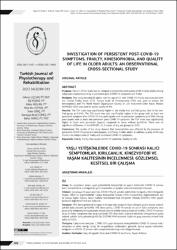INVESTIGATION OF PERSISTENT POST-COVID-19 SYMPTOMS, FRAILTY, KINESIOPHOBIA, AND QUALITY OF LIFE IN OLDER ADULTS: AN OBSERVATIONAL CROSS‑SECTIONAL STUDY
Access
info:eu-repo/semantics/openAccessDate
2023Author
Uçgun, HikmetKodaz, Elif
Arslan, Kübra
Soysal, Nisa Nur
Genç, Selen
Güneş, Sümeyya Betül
Akıncı, Buket
Metadata
Show full item recordCitation
Uçgun, H., Kodaz, E., Arslan, K., Soysal, N. N., Güneş, S. B., & Akıncı, B. (2023). INVESTIGATION OF PERSISTENT POST-COVID-19 SYMPTOMS, FRAILTY, KINESIOPHOBIA, AND QUALITY OF LIFE IN OLDER ADULTS: AN OBSERVATIONAL CROSS-SECTIONAL STUDY (0th ed., pp. 284-293). TURKISH JOURNAL OF PHYSIOTHERAPY REHABILITATION-TURK FIZYOTERAPI VE REHABILITASYON DERGISI. https://doi.org/10.21653/tjpr.1178637Abstract
Purpose: The aim of this study was to compare kinesiophobia and quality of life in older adults among subgroups created according to persistent post-COVID-19 symptoms and frailty.
Methods: This study included 63 adults over the age of 65 with COVID-19.. Frailty was assessed with the Clinical Frailty Scale (CFS). Tampa Scale of Kinesiophobia (TSK) was used to assess the kinesiophobia and The World Health Organization Quality of Life Instrument-Older Adults Module (WHOQOL-OLD) was used to assess quality of life.
Results: The TSK score was significantly higher in the visibly frail and frail group than in the non-frail group (p=0.040). The TSK score was also significantly higher in the group with at least one persistent symptom after COVID-19 than participants with no persistent symptoms (p=0.008). Among participants with at least one persistent post-COVID-19 symptom, the TSK score was significantly higher in those with persistent dyspnea compared to those without (p=0.016). There was no significant difference in the WHOQOL-OLD scores of any sub-groups (p>0.05).
Conclusion: The results of the study showed that kinesiophobia was affected by the presence of persistent COVID-19 symptoms and dyspnea, and frailty in older adults. In addition, quality of life was found to be independent of frailty and persistent COVID-19 symptoms.

















